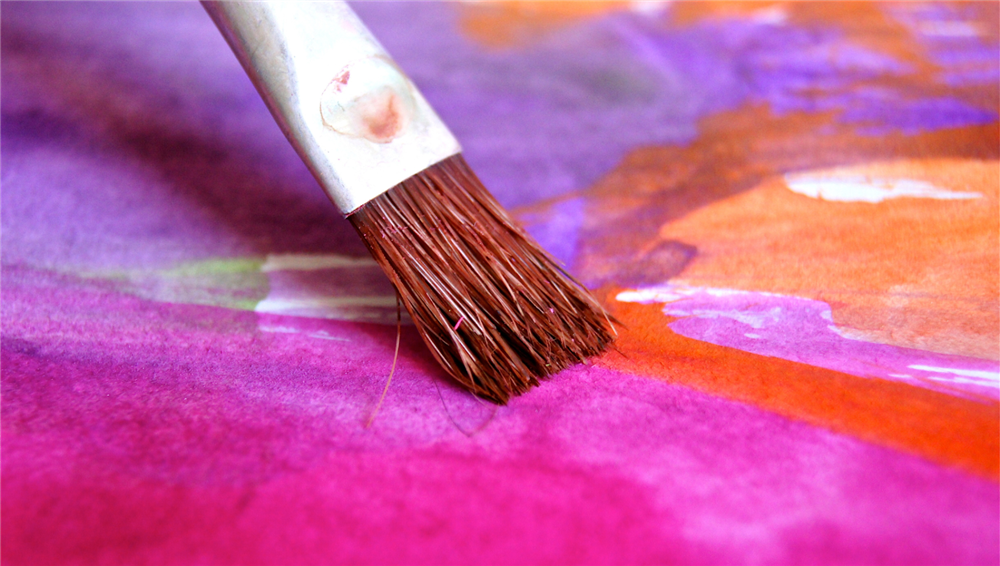Whether you’re new to painting or more of an experienced artist, Art to Art is here to help. And when it comes to acrylics, we know our stuff. Despite being one of the easiest paints to work with, acrylic isn’t just for the novice. Check out these creative acrylic painting techniques to take your art to the next level.
What you’ll need
- Acrylic paint
- Acrylic paint brushes
- Primed canvas (double thick or thin) or painting paper
- Acrylic mediums
- Palette knives and wedges
- Masking tape
- Easel
12 acrylic painting techniques with example pictures
1. Blending
Blending is a basic acrylic painting technique where two colours are gradually mixed together when applied to the canvas or paper, producing a smooth transition or gradient from one colour to the next. Commonly used to create skies and sunsets, as in this example.
2. Layering
Perhaps the most basic of acrylic painting techniques, layering involves painting on one layer of paint, the background for example, then waiting for it to dry before applying the next layer of paint (usually a different colour). This cloud-scape was created by painting the background night sky, letting it dry, then applying the white for the clouds over the top.
.png)
3. Dot painting
The dot painting technique is arguably one of the oldest in the world and is still commonly used in Aboriginal Australian art today.
.png)
4. Pouring
For this acrylic technique, you’ll need a pouring medium, which will allow the acrylic paint to become liquid enough to pour. Why not just use water? Because water will dilute the acrylic paint, creating more of a wash effect (see technique #5).
.png)
5. Washing
An acrylic paint wash is made by adding water to your acrylic paint mix and continuing to stir until you’ve achieved the desired runny consistency. This technique is especially useful for creating a translucent effect on the canvas or paper.
.png)
6. Drip
For drip painting, you can use liquid acrylics or simply thin out your thicker acrylics with water. Then load your brush with paint, or gently tip the paint container onto the top of the canvas and let the colour run down.
.png)
7. Glazing
A glaze can be achieved in acrylic painting by using a glazing medium, ideal for achieving depth and photorealistic effects. Simply mix the glazing liquid with your acrylic paint for added translucency, a rich oil-like gloss sheen and waterproof finish.
.png)
8. Swirl
Also known as the “dirty pour”, this acrylic pouring technique is achieved by adding your desired colours (mixed with pouring medium), one at a time, into a measuring cup, then pouring them onto the canvas using a slow, circular motion. Tip the canvas or board to cover the whole surface.
9. Scraping
The scraping technique is really effective when creating abstract backgrounds. Put some acrylic paint on your canvas or paper, then take a piece of pre cut cardboard or a straight piece of plastic (we like using an old bank or library card) and simply drag it through the colour in any direction. You can try adding different colours and scraping them through the original colour to create different blends.
10. Splatter or splash
Great for creating stars in the night sky, carefully add a small bit of paint to the end of your brush and ‘flick’ it towards the canvas or paper.
11. Using masking tape
To create crisp clean lines and geometric shapes, like in this example, stick your masking tape to the canvas to create the lines and shapes you want before you start painting. Then simply peel them off after you’ve finished painting!
.png)
12. Using a palette knife
Using a palette knife, you can achieve all sorts of textured effects with your acrylic painting. Use thick acrylic paint with a palette knife to scrape paint along the canvas or board, layer paint to create a 3D effect, or use the point of the knife to create dots. .png)
More inspo & helpful resources
FAQ
What are the basic must know painting techniques?
Some of the most basic painting techniques for acrylic painting are blending, layering, scraping and washing. Besides these, you can also create an entirely different style of work by using only dot painting.
What is the most common acrylic painting technique?
The most common and popular painting technique is layering. This is where you paint a layer of acrylic on your canvas, wait for it to dry, and then add another layer on top. This adds a sense of richness and depth to your painting.
How do I make my acrylic painting look professional?
Some techniques you can use to make your acrylic painting look more professional include using tools such as sponges and palette knives to create different effects and textures besides brush strokes. Varnishing or glazing your finished painting will also give it a glossy, photographic quality.





.png)
.png)
.png)
.png)